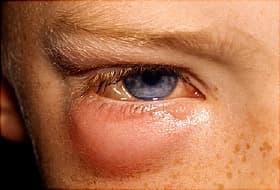Periorbital cellulitis is an infection of your eyelid or the skin around your eyes. Adults can get it, but children under 2 are most likely to have it.
It happens when bacteria attack the soft tissue around your eye, including your eyelid. These germs can get into your skin through a cut or scratch, or they can get to the area through an infection in your sinuses. It also can be a reaction to a stye (a tender bump on your eyelid that forms when a gland on your eyelid gets infected).

Symptoms
The most common signs of periorbital cellulitis are:
- Redness and swelling around the eye
- A cut, scratch, or insect bite near the eye
- The skin in the affected area is tender to the touch and might feel a little tough.
- The white of the eye might look red.
Periorbital cellulitis doesn’t cause a fever or pain. If you or your child has a fever and swelling and it hurts to move the affected eye, get medical help right away. These things can be caused by a more serious condition called orbital cellulitis that affects the eye itself.
Diagnosis
If your doctor thinks you or your child might have periorbital cellulitis, they’ll start by looking for signs of an injury or a stye. They also might want to see how well your eyes move and respond to light.
They may take a sample of blood or any drainage from your eye to test and find out what type of bacteria is causing the problem. They may want to get a closer look with X-rays or a computerized tomography (CT) scan. This is when X-rays taken from different angles are put together to make a more complete picture.
Treatment
If you or your child has periorbital cellulitis, the doctor will prescribe oral antibiotics, and these should start to work within 24 to 48 hours. You’ll probably need to schedule a follow-up visit or two to make sure the infection is completely gone.

